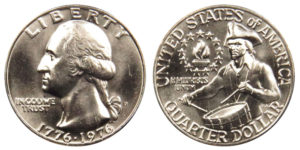What are Bicentennial Coins?
 Series of commemorative coins that bear “1776-1976”. The US Mint struck these coins from 1975 to 1976 and issued them into circulation. 40% silver-clad variations minted for collectors.
Series of commemorative coins that bear “1776-1976”. The US Mint struck these coins from 1975 to 1976 and issued them into circulation. 40% silver-clad variations minted for collectors.
The bicentennial coinage is a set of commemorative coins including a quarter, half-dollar, and dollar created by the United States Mint. Each coin is stamped with the dates 1776 – 1976 regardless of when they were minted. The U.S. Congress mandated that 45,000,000 part-silver pieces be minted for coin collectors. The U.S. Mint sold more than half of the coins before melting the remaining after 1986.
The U.S. Department of the Treasury held a competition during October 1973 for U.S. citizens to submit designs for some of the coins in the series. A competitor could submit a drawing or photograph for the Treasury Secretary along with a panel of judges to judge.
The final coins minted of the Bicentennial series included half dollars in honor of George Washington Carver and Booker T. Washington and was discontinued in 1954. Since many of these coins could not be sold at prestige prices, they entered circulation. S.J. Phillips was the promotor of these coins and poorly managed the distribution. This mismanagement lost the Department of Treasury $140,000 creating negative publicity. The negative publicity caused the Department of the Treasury to deny successive proposals for commemorative coins until the 1970s. The initial 1975 Bicentennial coins minted were dollars meant for the public, and the first collector’s coins were minted in San Francisco Assay office. More than 45,000,000 silver coins were minted.
Due to the large quantities of the bicentennial coins minted they remain inexpensive.
What people ask…
How much is a 1976 Bicentennial coin worth?
How much is the bicentennial quarter worth today?
How much is an Eisenhower Bicentennial dollar worth?
How much is a 1976 Drummer Boy quarter worth?
Back to All Terms
